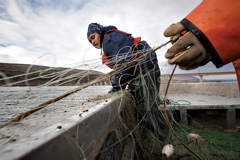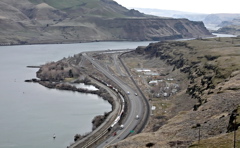forum
library
tutorial
contact

Remembering Celilo Falls
by Phil FerolitoYakima Herald-Republic, March 4, 2007
|
the film forum library tutorial contact |

|
Remembering Celilo Fallsby Phil FerolitoYakima Herald-Republic, March 4, 2007 |
 CELILO VILLAGE, Ore. -- Deliliah Begay and daughter Chauntai reach into the Columbia River from their aluminum boat to pull in a gill net.
CELILO VILLAGE, Ore. -- Deliliah Begay and daughter Chauntai reach into the Columbia River from their aluminum boat to pull in a gill net.
A brisk winter wind cuts through the gorge as the 17-foot boat pitches in the river's swells.
From the net, Begay wrestles out a sturgeon while Chauntai continues to tug the rest of the massive net aboard.
In all, five sturgeon -- two measuring nearly 5 feet long -- are pulled from the net.
"These two are pretty good size," says the 35-year-old Begay. "They should weigh out pretty good."
The two Yakamas then replace the net in a section of river not far from where Celilo Falls was silenced 50 years ago this week.
For countless generations, Columbia River Indians fished here, dipping handheld nets into the swirling water as they stood atop wood scaffolds anchored to the falls' jagged walls and islands.
Roughly 1,000 Indians lived at nearby Celilo Village, and many more lived in surrounding communities. But that was before The Dalles Dam flooded the ancient fishing site and trading post that drew Indians from as far as the Great Plains and California to fish or trade goods for dried salmon.
Next weekend, tribal members and others will gather at Celilo Village to commemorate the 50th anniversary of the falls' flooding. Today, it is a far quieter river on which tribal members use large nets and boats to fish.
The once vibrant village is little more than about a dozen mostly tattered homes and a longhouse, backed by cliffs and separated from the river by a busy rail line and the constant traffic of Interstate 84.
Fish runs are a fraction of what they once were, but tribal members continue their sacred fishing practices here.
Begay pulls her five nets about three times a week for fish for ceremonies, and to sell and eat.
Chauntai, a 16-year-old high school junior, comes along when she's not in school.
"We're just exercising our traditional rights," says Begay. "It's a natural right for us Indians on this river."
A somber cloud hung over the falls on March 10, 1957, as The Dalles Dam's gates closed and a way of life slipped beneath the water, recalls 79-year-old Joe Jay Pinkham, who grew up fishing at the falls.
 About 400 Indians from the Yakama, Warm Springs, Umatilla and Nez Perce tribes tearfully gathered for a last look at a place they often called "one of the seven wonders of the world."
About 400 Indians from the Yakama, Warm Springs, Umatilla and Nez Perce tribes tearfully gathered for a last look at a place they often called "one of the seven wonders of the world."
Traditional songs filled the air as the water rose, recalls Pinkham.
"It was a sad day," he remembers.
Pinkham, now secretary to the Yakama General Council, recalls racing to the dam with a few other fishermen to see dam doors close before heading back to the village, where three of his children were born.
"You could see it filling up," he recalls. "You could see all those little islands disappear."
Many couldn't bear to watch, says Johnny Jackson, chief of the Cascade band of the Yakamas.
"There were a lot of people that didn't want to look at it," recalls Jackson, who also used to fish at the falls. "They turned their backs." In less than five hours, the falls were submerged and everyone headed into the Celilo Longhouse for a dinner, Pinkham recalls.
Fifty years later, tears puddle in his eyes as he recalls that day.
"The roar left us just like that," he says.
Saddened by the loss, Pinkham says, he and his friend left immediately after the dinner.
"Celilo -- it meant a lot to our people," he says.
He says he never fished the Columbia River again.
Celilo Falls meant much more to Columbia River Indians than just fishing and trading. It was a spiritual place where they could give thanks for the land and honor the salmon.
Columbia River Indians believe that the salmon offered itself as food so man could live on Earth. The falls -- where returning salmon were plentiful -- were at the center of that belief.
 "It was the center of the Pacific Northwest for time immemorial," says 55-year-old Karen Jim Whitford, daughter of the late Celilo Chief Howard Jim.
"It was the center of the Pacific Northwest for time immemorial," says 55-year-old Karen Jim Whitford, daughter of the late Celilo Chief Howard Jim.
In 1848, a territorial act promised no dam would be built if it prevented fish from spawning. It was the first in a long line of broken promises.
Dam builders in the U.S. Corps of Engineers, said fish passages at the dam would improve fish runs by making the river easier to navigate. That didn't happen.
The dam has no fish ladders, but now uses a spillway to help spawning salmon return. (bluefish corrects: the four lower Columbia dams and the four lower Snake River dams are all equipped with fish ladders to aid upstream adult migration.)
During negotiations before the dam was built, some 8,000 Columbia River tribal members were given about $3,000 each by the federal government -- totaling more than $26.7 million in all -- for their cultural loss and to move onto the reservation.
"That's only a drop in the bucket compared to the electricity bills everyone pays," Whitford says.
Homes and drying sheds along the river were destroyed to make way for the dam and the huge pool it would create. Rocks were blasted as a channel was carved through the center of the falls to ease ship and barge traffic.
Some river families were divided among the Yakama, Warm Springs, Umatilla and Nez Perce tribes, and scattered from Idaho and Oregon to the Yakima Valley, Whitford notes.
Families who didn't want to leave their ancestral ties to the area were promised new homes. But decades later, they remain in most of the 14 original houses with peeling siding, flaking roofs, and a lack of furnaces and air conditioning.
Made of World War II surplus material, the houses were supposed to be temporary.
The village's water system has been contaminated with salmonella in the past and the sewer system often backs up.
A single dirt road loops through the village. Fishing boats dot the area and some uninhabitable homes have been abandoned for trailers.
"The elders would always say, 'They're going to build us new homes,'" recalls Whitford's brother, Ronald Jim. "They would always have their hopes up, but then nothing would happen."
It's not clear why the village wasn't included in 1988 federal legislation making treaty fishing site communities eligible for refurbishing.
But now the Corps of Engineers, which built and operates the dam that generates enough power to supply a city the size of Seattle, is beginning to make good on a 50-year-old promise.
Less than two years ago, it spent about $1 million to construct a new longhouse where religious ceremonies are held.
Families are still awaiting new homes. But construction on a new water system and septic ponds at the village have begun. Work on new homes is scheduled to start in July. The entire project is expected to be finished in about a year and half.
"They said this was temporary, and look how long it's taken," Whitford says.
Commemorating the loss of Celilo Falls isn't easy for many elders, says Whitford, who was 5 years old when the falls were covered. "It's a big heartache," she says. "What did we do wrong to lose our falls? Why?"
Many non-Indians just didn't feel the same way about the falls, says history professor Katrine Barber at Portland State University's Department of Native American studies.
Many non-Indians in the area at the time thought the dam would bring wealth to the community and allow The Dalles to grow into a metropolitan hub, she says.
But when that didn't happen, and as non-Indian commercial fisherman began to see the decline in fish runs, a different attitude toward the dam began to form, she says.
Standing in her single-wide trailer at the village, Whitford hopes that this weekend's ceremonies could serve as some kind of healing for some. But mostly, she says, it's a memorial. She describes the day the falls were covered as "like a funeral -- it was a big loss to us."
"Celilo Falls may be gone, but it still echoes in our hearts," she says, tapping her chest. "It didn't die here, it's still here."
learn more on topics covered in the film
see the video
read the script
learn the songs
discussion forum
